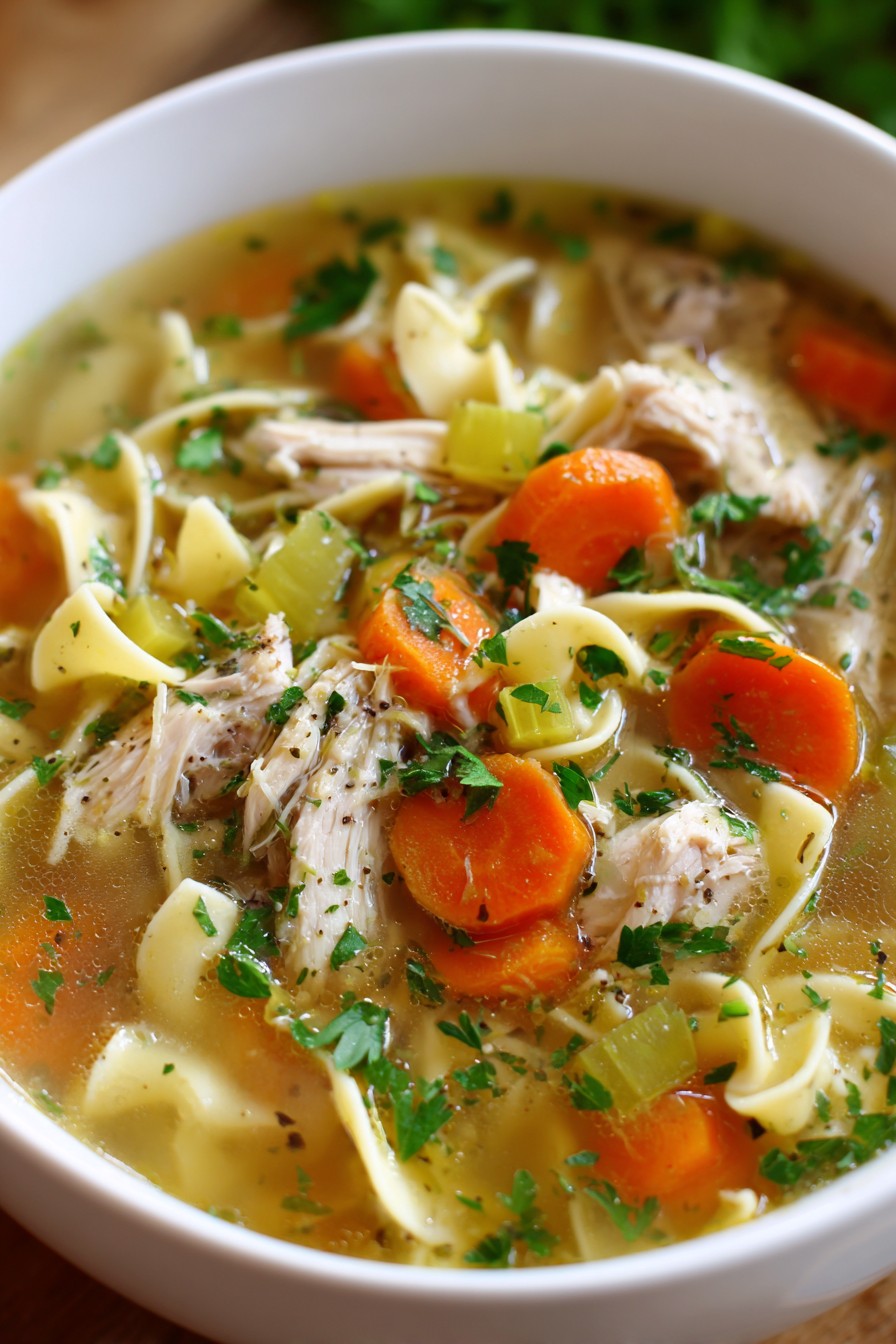Kick back and let your slow cooker do all the work while you reap the rewards of the most comforting bowl of chicken noodle soup imaginable. Kind of magical how a handful of simple ingredients transforms into liquid gold after a few hours of gentle simmering, isn’t it? Knowing you’ve got dinner handled without hovering over a stove is the ultimate weeknight win.
Why This Recipe Works
- The slow cooker’s low, steady heat gently coaxes maximum flavor from chicken thighs, creating an incredibly rich and savory broth without any risk of overcooking or drying out the meat.
- Adding the egg noodles during the final 30 minutes ensures they maintain perfect al dente texture rather than turning into a mushy, bloated mess that can happen with longer cooking times.
- Starting with sautéed aromatics like onions, carrots, and celery builds a deep flavor foundation that powdered soup mixes simply can’t compete with, giving you restaurant-quality results from your countertop.
- Using both fresh herbs during cooking and a bright finish of lemon juice and parsley at serving time creates layers of freshness that cut through the richness and make each spoonful exciting.
- The hands-off approach means you can literally toss everything in the pot in five minutes flat, then walk away for hours while your kitchen fills with the most inviting aromas known to humankind.
Ingredients
- 2 pounds boneless, skinless chicken thighs, trimmed of excess fat and cut into 1-inch chunks
- 1 large yellow onion, finely diced (about 2 cups)
- 3 medium carrots, peeled and sliced into ¼-inch rounds (about 1½ cups)
- 3 celery stalks, sliced into ¼-inch pieces (about 1½ cups)
- 4 cloves garlic, minced
- 8 cups low-sodium chicken broth
- 2 bay leaves
- 1 teaspoon dried thyme
- 1 teaspoon onion powder
- ½ teaspoon black pepper, freshly ground
- 1½ teaspoons kosher salt, plus more to taste
- 8 ounces wide egg noodles, uncooked
- 2 tablespoons fresh parsley, finely chopped
- 2 tablespoons fresh lemon juice
- 2 tablespoons unsalted butter
Equipment Needed
- 6-quart or larger slow cooker
- Cutting board
- Chef’s knife
- Measuring cups and spoons
- Large skillet (optional, for sautéing)
- Ladle
- Tongs
Instructions

Prepare Your Aromatics and Chicken
Begin by prepping all your vegetables and chicken to ensure everything cooks evenly and you’re not scrambling mid-recipe. Finely dice one large yellow onion until you have about two cups, then peel and slice three medium carrots into consistent ¼-inch rounds until you have approximately one and a half cups. Slice three celery stalks similarly, and mince four cloves of garlic—don’t be shy with the garlic, it mellows beautifully during slow cooking. Trim any excess fat from two pounds of boneless, skinless chicken thighs, then cut them into one-inch chunks; thighs stay juicier than breasts during long cooking. Pro tip: if you have five extra minutes, quickly sauté the onions, carrots, and celery in a tablespoon of oil until slightly softened—this deepens their flavor immensely in the final soup.
Combine Everything in the Slow Cooker
Now for the satisfying dump-and-stir phase that makes slow cooker recipes so brilliant. Place your prepped chicken chunks into the slow cooker insert, followed by the diced onion, sliced carrots, celery, and minced garlic. Pour in eight cups of low-sodium chicken broth—using low-sodium lets you control the salt level perfectly later. Add two bay leaves, one teaspoon of dried thyme, one teaspoon of onion powder, half a teaspoon of freshly ground black pepper, and one and a half teaspoons of kosher salt. Give everything a good stir to distribute the seasonings evenly and ensure the chicken is submerged. Place the lid securely on your slow cooker and set it to cook on low for six to seven hours or on high for three to four hours—low and slow is always better for flavor development.
Check for Doneness and Adjust Seasonings
Once your cooking time is up, carefully remove the lid—steam alert!—and admire the beautiful broth you’ve created. The chicken should be extremely tender and easily shreddable with a fork. Use tongs to remove the chicken pieces to a cutting board or bowl, then shred them with two forks into bite-sized pieces. Discard the bay leaves—they’ve done their job. Taste the broth and adjust seasoning if needed; you might want another half teaspoon of salt or a pinch more pepper depending on your palate. Pro tip: if the broth tastes a bit flat, add a teaspoon of chicken bouillon paste or powder—it’s like a flavor booster shot without making it overly salty.
Cook the Noodles to Perfect Tenderness
Finish with Fresh Flavors and Serve
Once your noodles are perfectly cooked, it’s time to add the bright, fresh elements that elevate this from good to unforgettable. Turn off the slow cooker and stir in two tablespoons of fresh lemon juice—this little hit of acidity balances the richness beautifully. Add two tablespoons of unsalted butter for a silky, luxurious mouthfeel, and finally stir in two tablespoons of freshly chopped parsley for color and freshness. Ladle the soup into bowls and serve immediately while it’s piping hot. This soup is fantastic with crusty bread for dipping or a simple green salad on the side. Leftovers will keep well in the refrigerator for up to four days, though the noodles will continue to absorb broth.
Tips and Tricks
For the absolute best flavor development, take the extra five minutes to sauté your onions, carrots, and celery before adding them to the slow cooker. This caramelization step adds a depth of flavor that raw vegetables simply can’t achieve, giving your broth a richer, more complex base. If you’re short on time, you can skip it, but honestly, the difference is noticeable and worth the minimal effort. When prepping your chicken, make sure to trim any large pieces of fat—thighs have more fat than breasts, which adds flavor, but you don’t want big greasy pieces floating in your finished soup. If you prefer white meat, chicken breasts can be used, but reduce the cooking time by about an hour on low or thirty minutes on high to prevent them from becoming dry and stringy.
Regarding broth selection, low-sodium is crucial because it allows you to control the salt level precisely. Regular broth can make the soup overly salty, especially since reducing concentrates flavors. If you only have regular broth, use half broth and half water, or omit the added salt until the end. For an even richer broth, consider using homemade chicken stock if you have it—the gelatin content gives incredible body and mouthfeel. Herbs make a significant difference too; while dried thyme works fine, if you have fresh thyme, use three sprigs instead of dried and remove them before serving. Fresh herbs generally provide a brighter, more vibrant flavor profile compared to their dried counterparts.
Noodle management is perhaps the most critical tip for success with this recipe. If you know you’ll have leftovers, cook the noodles separately and add them to individual bowls rather than the whole pot. This prevents them from turning into a bloated, mushy mess as they sit in the broth. Wide egg noodles are classic, but feel free to experiment with other pasta shapes like ditalini, orzo, or even gluten-free options—just adjust cooking times according to package directions. If your soup seems too thick after adding the noodles, simply stir in a bit more warm broth or water to reach your desired consistency. Conversely, if it’s too thin, make a quick slurry with two tablespoons of cornstarch and four tablespoons of cold water, stir it in, and cook for fifteen minutes on high to thicken.
Finally, don’t underestimate the power of finishing touches. The fresh lemon juice added at the end brightens all the flavors and cuts through the richness—taste before and after adding it and you’ll be amazed at the transformation. The butter adds a restaurant-quality silkiness, but you can omit it for a lighter version. For serving, have extra lemon wedges, chopped parsley, grated Parmesan cheese, and red pepper flakes on the table so everyone can customize their bowl. This soup freezes well without noodles—freeze portions before adding noodles, then when reheating, cook fresh noodles separately and add them to the thawed soup.
Recipe Variations
- Creamy Version: For a decadent twist, stir in one cup of heavy cream or half-and-half during the last thirty minutes of cooking. Add a quarter cup of grated Parmesan cheese along with the cream for extra richness. This creates a velvety, comforting soup that’s perfect for chilly days. Reduce the initial broth by one cup to account for the added liquid, and be careful not to boil after adding dairy to prevent curdling.
- Spicy Kick: If you like heat, add one diced jalapeño (seeds removed for milder heat) with the other vegetables. Stir in one teaspoon of red pepper flakes with the dried herbs, and finish with a drizzle of chili oil or hot sauce at serving time. You could also use spicy chicken sausage instead of half the chicken for a different flavor profile—slice it into coins and brown before adding.
- Vegetable-Packed: Boost the nutrition by adding two cups of chopped spinach or kale during the last thirty minutes of cooking. Other great additions include one cup of frozen peas, one cup of corn kernels, or even a diced potato for more substance. For extra protein, add one can of drained and rinsed white beans when you add the noodles—they’ll heat through perfectly.
- Asian-Inspired: Create a completely different flavor profile by using ginger and soy instead of traditional herbs. Replace the thyme with one tablespoon of freshly grated ginger, use low-sodium soy sauce instead of salt, and add two star anise pods. Use rice noodles instead of egg noodles, and finish with lime juice instead of lemon, plus chopped cilantro and sliced green onions.
- Italian Twist: Give it a minestrone feel by adding one can of diced tomatoes, one teaspoon of dried oregano, and a Parmesan rind while cooking. Use ditalini pasta instead of egg noodles, and stir in two cups of chopped escarole or spinach at the end. Finish with a drizzle of extra virgin olive oil and more grated Parmesan on top.
Frequently Asked Questions
Can I use chicken breasts instead of thighs?
Absolutely, you can substitute boneless, skinless chicken breasts for the thighs if you prefer white meat. However, because breasts have less fat and can dry out more easily during long cooking, I recommend reducing the cooking time by about one hour if cooking on low or thirty minutes if cooking on high. Check for doneness early—the chicken should reach an internal temperature of 165°F and shred easily. Some people find that a mix of half thighs and half breasts gives the best of both worlds: flavor from the thighs and lean protein from the breasts.
How can I make this recipe gluten-free?
Making this soup gluten-free is simple with a couple of easy swaps. First, ensure your chicken broth is certified gluten-free, as some brands may contain hidden gluten. Second, replace the regular egg noodles with your favorite gluten-free pasta—brown rice noodles, chickpea pasta, or lentil noodles all work well. Add gluten-free noodles during the last twenty to thirty minutes of cooking, but check the package directions as cooking times vary. You could also use spiralized zucchini or spaghetti squash instead of pasta for a low-carb, gluten-free option.
Why did my noodles turn out mushy?
Mushy noodles typically happen when they cook too long or sit in the hot broth after cooking. Egg noodles continue to absorb liquid and soften even after the heat is off, so timing is crucial. Always set a timer for exactly thirty minutes when cooking noodles on high, and test one at twenty-five minutes to be safe. If you’re not serving immediately, cook noodles separately and add them to individual bowls. For leftovers, store noodles and broth separately if possible, or expect that reheated noodles will be softer—they’ll still taste great but have a different texture.
Can I freeze this chicken noodle soup?
You can freeze this soup, but with one important caveat: freeze it without the noodles. Cooked noodles become extremely soft and mushy when frozen and thawed, losing their pleasant texture. Freeze the broth with chicken and vegetables only, then when ready to serve, thaw overnight in the refrigerator, reheat on the stove or in the slow cooker, and cook fresh noodles separately to add at the end. Properly stored in airtight containers, the soup base will keep well in the freezer for up to three months.
How can I make the broth richer and more flavorful?
For a more robust broth, try sautéing the vegetables until deeply caramelized before adding them to the slow cooker—this builds incredible flavor foundations. Using homemade chicken stock instead of store-bought broth makes a significant difference due to its higher gelatin content. Adding a Parmesan rind while cooking infuses umami richness—remove it before serving. Finally, don’t skip the finishing touches: the butter added at the end emulsifies into the broth creating silkiness, while lemon juice brightens and enhances all the other flavors.
Summary
This set-it-and-forget-it crock pot chicken noodle soup delivers maximum comfort with minimal effort. Tender chicken, perfectly cooked noodles, and aromatic vegetables simmer into soul-warming perfection while you go about your day. Customize with your favorite variations and enjoy the ultimate cozy meal.



